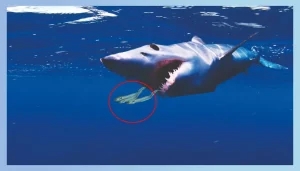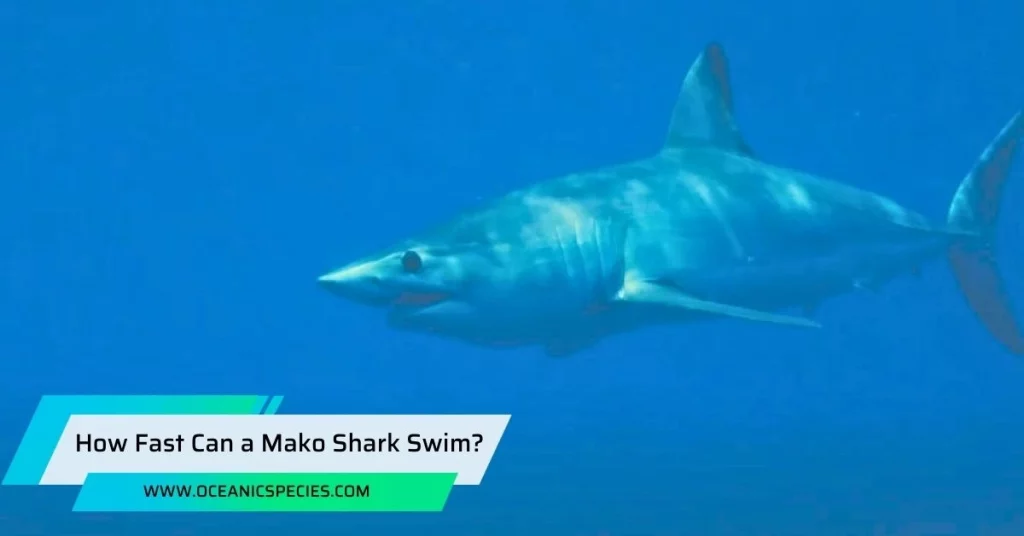A mako shark can swim at speeds of up to 45 miles per hour. Mako sharks are one of the fastest swimming sharks in the ocean, capable of swift and agile movements.
With their streamlined bodies and powerful tails, they can reach impressive speeds while hunting or evading predators. Their speed enables them to catch fast prey, such as tuna and swordfish. Due to their exceptional swimming abilities, mako sharks are considered formidable predators in the ocean.
They are known for their sleek design, sharp teeth, and remarkable bursts of speed, making them fascinating creatures to study and admire.
Factors Affecting Mako Shark Speed

Mako shark speed is influenced by various factors, including their streamlined body shape, powerful muscles, and unique adaptations, allowing them to reach top speeds. These factors enable them to swift through the ocean with incredible agility.
Streamlined Body Shape:
Mako sharks have a sleek, torpedo-shaped body that is perfectly designed for speed and maneuverability in the water. Their long, slender bodies help reduce drag as they cut through the ocean, allowing them to swim more efficiently. The smooth, tapered shape of their body minimizes turbulence and allows them to maintain their momentum, enabling them to reach incredible speeds.
Powerful Muscles:
Mako sharks possess a unique set of powerful muscles, particularly their caudal (tail) muscles, which play a vital role in their high-speed swimming. These muscles are incredibly strong and enable the shark to rapidly move its tail from side to side, propelling it through the water with great force. The muscles in its pectoral fins also contribute to its swimming abilities, providing stability and precise control during quick turns and maneuvers.
Large Caudal (Tail) Fin:
The caudal fin of a mako shark is an essential component of its impressive swimming capabilities. This fin is proportionally larger compared to other shark species and is shaped like a crescent or half-moon. The size and shape of the caudal fin provide the shark with exceptional agility, allowing it to make sudden changes in direction and swim at high speeds effortlessly.
Hunting Techniques Of Mako Sharks

Mako sharks’ incredible speed allows them to efficiently hunt and capture their prey, making them formidable predators in their underwater domain. They are known for their incredible speed and agility in the water, making them skillful hunters.
Let’s take a deeper look at the hunting techniques of these remarkable creatures.
Ambush Hunting
Mako sharks are master ambush predators, relying on their speed to surprise their prey. They use their sleek bodies and agility to hide in the depths and launch sudden attacks on unsuspecting prey. When the perfect opportunity arises, the mako shark bursts out of hiding, taking its prey by surprise. This hunting technique allows the mako shark to quickly capture its prey before it has a chance to escape.
High-Speed Chase
Using their strong, streamlined bodies and powerful tails, they accelerate to incredible velocities in pursuit of prey. Mako sharks are capable of maintaining these high speeds for short bursts, enabling them to catch up to fast-swimming fish. Their speed and agility give them the advantage in a chase, making it difficult for their prey to escape.
Hunting Prey In Groups
While mako sharks are often solitary hunters, there are instances where they cooperate and hunt in groups. These group hunting behaviors usually occur when there is an abundance of prey in a specific location. By coordinating their movements, mako sharks can surround schools of fish, making it easier to pick off individual prey. This cooperative hunting strategy allows the mako sharks to secure a greater number of meals in a shorter amount of time.
Physical Adaptations For Speed
Mako shark’s physical adaptations allow it to swim swiftly through the ocean in pursuit of prey. Let’s take a closer look at some of the key physical adaptations that enable the mako shark to reach such impressive speeds:
Body Shape And Hydrodynamics
- Streamlined body: The mako shark has an elongated, torpedo-shaped body, which minimizes drag as it cuts through the water.
- Ampullae of lorenzini: These small, jelly-filled pores on the mako shark’s snout help detect slight changes in water pressure, aiding in navigation and pursuit of prey.
- “v”-shaped snout: The mako shark’s pointed, “v”-shaped snout helps to reduce drag by directing water flow around the shark’s body.
- Dorsal fin placement: The mako shark’s dorsal fin is positioned farther back on its body, providing stability and reducing drag.
- Large pectoral fins: The mako shark’s large pectoral fins allow it to generate lift and control its movements, contributing to its impressive speed.
Muscle Structure And Efficiency
- Red muscle fibers: The mako shark possesses a high percentage of red muscle fibers, which are rich in oxygen-carrying myoglobin. This enables sustained swimming over long distances and rapid bursts of speed.
- Powerful muscles: The mako shark has a robust musculature, particularly in its tail and jaw, providing the necessary power for quick accelerations and agile movements.
- Efficient heat regulation: The mako shark has specialized blood vessels called retia mirabilia that help regulate its body temperature during intense activity, ensuring optimal muscle performance.
Tail Fin Design
- Lunate tail shape: The mako shark boasts a crescent-shaped, or lunate, tail, which maximizes propulsion efficiency by creating strong forward thrust while minimizing drag.
- Heterocercal tail: The mako shark’s tail is asymmetrical, with a longer upper lobe and a shorter lower lobe. This tail design helps maintain stability and provides excellent maneuverability.
- Horizontal tail fin placement: The mako shark’s tail is positioned horizontally, allowing for efficient up-and-down movement, effective changes in direction, and remarkable bursts of speed.
Research And Measurement Methods
Mako sharks are known for their remarkable speed, capable of swimming at incredible speeds. This section explores the research and measurement methods employed to track the speed of mako sharks.
Speed Tracking Devices:
- Acoustic tags: Researchers attach acoustic tags to mako sharks, allowing them to track the sharks’ movements and speed through sound waves. These tags emit signals that are picked up by receivers strategically placed in the water.
- Satellite tags: Satellite tags are used to track the speed of mako sharks over long distances. These tags transmit data to satellites, providing researchers with valuable insights into the sharks’ speed, location, and behavior.
Study Findings And Accuracy:
- High speed recorded: Through the use of speed tracking devices, researchers have found that mako sharks can reach impressive speeds. They have been recorded swimming at speeds of up to 45 miles per hour (72 kilometers per hour).
- Variations in speed: Studies have shown that the speed of mako sharks can vary depending on factors such as age, size, and environmental conditions. Larger and more mature sharks tend to swim faster than younger ones.
- Accuracy of measurements: While the tracking devices used by researchers provide valuable data, it is important to note that measurements may have a margin of error. Factors like water current, device limitations, and the behavior of the mako sharks can influence the accuracy of speed measurements.
Challenges In Measuring Speed:
- Unpredictable behavior: Mako sharks are highly dynamic creatures, known for their erratic and unpredictable swimming patterns. This makes it challenging for researchers to accurately measure their top speeds.
- Environmental factors: Water temperature, currents, and turbidity can affect the accuracy of speed measurements. These variables need to be taken into account when studying mako sharks’ swimming abilities.
- Device limitations: The technology used to track the speed of mako sharks is continuously advancing, but there are still limitations to consider. Factors like battery life, signal range, and attachment methods can impact the effectiveness of speed tracking devices.
Researchers utilize various tools, including acoustic and satellite tags, to measure the speed of mako sharks. These methods have provided invaluable insights into their swimming capabilities, revealing remarkable speeds of up to 45 miles per hour. However, challenges such as unpredictable behavior and environmental factors can affect measurement accuracy.
Nonetheless, ongoing research and advancements in technology will continue to enhance our understanding of how fast mako sharks can truly swim.
How To Safely Encounter Mako Sharks

Discover the astonishing speed of the mako shark as it propels through the water, reaching an impressive top speed of up to 45 miles per hour. Learn how to safely encounter these swift predators in their natural habitat.
Mako sharks are known for their incredible speed in the water. So, how fast can a mako shark swim? Let’s find out! In this section, we’ll also discuss how to safely encounter these majestic creatures.
Tips For Divers And Swimmers
- Stay calm and avoid sudden movements: Makos are highly sensitive to vibrations and sudden movements may startle them. It’s important to remain calm and avoid any rapid actions that could agitate the sharks.
- Maintain a safe distance: Keep a respectful distance between yourself and the mako sharks. This is not only for your safety but also to ensure the sharks are not disturbed or stressed.
- Avoid direct eye contact: Eye contact can be interpreted as a threat by sharks. It’s best to avoid direct eye contact and instead focus on observing them from a distance.
- Do not touch or provoke the sharks: Touching or provoking mako sharks is not only dangerous for you but also disrupts their natural behavior. Keep a hands-off approach and enjoy observing them in their natural habitat.
- Respect the ecosystem: Remember that you are a guest in the shark’s home. Be mindful of the surrounding marine life and avoid disturbing the environment.
Responsible Handling And Fishing Practices
- Catch and release: If you’re engaged in recreational fishing for makos, it’s crucial to practice catch and release. This helps preserve the population and ensures the sharks can continue to thrive in their habitat.
- Use appropriate gear: When fishing for makos, make sure you use appropriate gear that is suitable for handling large and powerful sharks. Using heavy-duty equipment can help reduce stress and potential harm to both the sharks and anglers.
- Remove hooks carefully: If you do catch a mako shark, it’s important to remove the hook as quickly and carefully as possible. This can be done using specialized tools or by cutting the line near the hook to minimize damage.
- Support sustainable fishing practices: Choose to support organizations and initiatives that promote sustainable fishing methods and conservation efforts. This helps protect not only mako sharks but also the overall marine ecosystem.
Frequently Asked Questions
How Do Mako Sharks Achieve Such Incredible Speed?
Mako sharks have a streamlined body, powerful muscles, and a large crescent-shaped tail that helps propel them through the water with incredible speed.
What Do Mako Sharks Eat?
Mako sharks primarily feed on smaller fish, such as mackerel and tuna, but they are also known to eat squid and even other sharks.
Where Can Mako Sharks Be Found?
Mako sharks are found in tropical and temperate waters around the world, including the atlantic, indian, and pacific oceans.
Are Mako Sharks Dangerous To Humans?
While mako sharks are known to be aggressive when provoked, they rarely attack humans. However, caution should always be exercised when swimming in areas where mako sharks are known to reside.
Conclusion
The mako shark is undoubtedly one of the fastest species in the ocean, reaching impressive speeds of up to 45 miles per hour. Its streamlined body, powerful muscles, and ergonomic tail allow it to cut through the water with incredible agility and efficiency.
This remarkable speed enables the mako shark to hunt down its prey with ease, making it a formidable predator in the marine world. It is fascinating to learn about the adaptations and characteristics that enable these creatures to swim at such impressive speeds.





